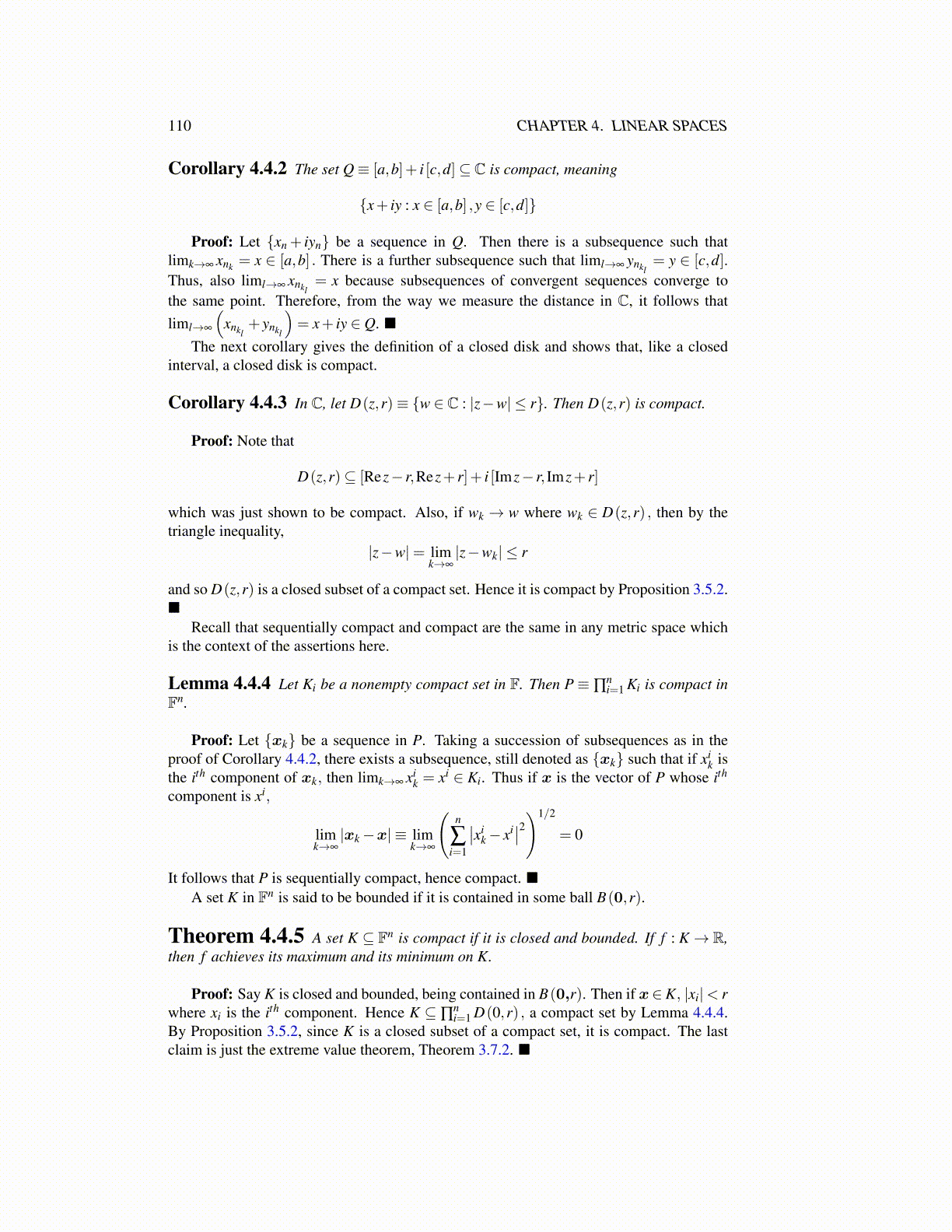
110 CHAPTER 4. LINEAR SPACES
Corollary 4.4.2 The set Q≡ [a,b]+ i [c,d]⊆ C is compact, meaning
{x+ iy : x ∈ [a,b] ,y ∈ [c,d]}
Proof: Let {xn + iyn} be a sequence in Q. Then there is a subsequence such thatlimk→∞ xnk = x ∈ [a,b] . There is a further subsequence such that liml→∞ ynkl
= y ∈ [c,d].Thus, also liml→∞ xnkl
= x because subsequences of convergent sequences converge tothe same point. Therefore, from the way we measure the distance in C, it follows thatliml→∞
(xnkl
+ ynkl
)= x+ iy ∈ Q. ■
The next corollary gives the definition of a closed disk and shows that, like a closedinterval, a closed disk is compact.
Corollary 4.4.3 In C, let D(z,r)≡ {w ∈ C : |z−w| ≤ r}. Then D(z,r) is compact.
Proof: Note that
D(z,r)⊆ [Rez− r,Rez+ r]+ i [Imz− r, Imz+ r]
which was just shown to be compact. Also, if wk → w where wk ∈ D(z,r) , then by thetriangle inequality,
|z−w|= limk→∞
|z−wk| ≤ r
and so D(z,r) is a closed subset of a compact set. Hence it is compact by Proposition 3.5.2.■
Recall that sequentially compact and compact are the same in any metric space whichis the context of the assertions here.
Lemma 4.4.4 Let Ki be a nonempty compact set in F. Then P≡ ∏ni=1 Ki is compact in
Fn.
Proof: Let {xk} be a sequence in P. Taking a succession of subsequences as in theproof of Corollary 4.4.2, there exists a subsequence, still denoted as {xk} such that if xi
k isthe ith component of xk, then limk→∞ xi
k = xi ∈ Ki. Thus if x is the vector of P whose ith
component is xi,
limk→∞
|xk−x| ≡ limk→∞
(n
∑i=1
∣∣xik− xi∣∣2)1/2
= 0
It follows that P is sequentially compact, hence compact. ■A set K in Fn is said to be bounded if it is contained in some ball B(0,r).
Theorem 4.4.5 A set K ⊆ Fn is compact if it is closed and bounded. If f : K→ R,then f achieves its maximum and its minimum on K.
Proof: Say K is closed and bounded, being contained in B(0,r). Then if x∈K, |xi|< rwhere xi is the ith component. Hence K ⊆ ∏
ni=1 D(0,r) , a compact set by Lemma 4.4.4.
By Proposition 3.5.2, since K is a closed subset of a compact set, it is compact. The lastclaim is just the extreme value theorem, Theorem 3.7.2. ■